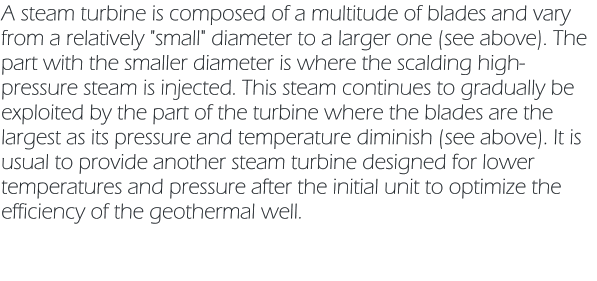

Offshore geothermal resources (June 2022)


Click on the
octopus to return to
the top of the page


Authors: Darren Atkins and Haraldur Audunsson
The world’s oceans hold abundant geothermal
resources, none of which are being utilized today. The
majority of these high-temperature resources lie along
mid-ocean ridges.
The authors describe exploration techniques that can
be used for locating hydrothermal vents, such as
towing a variety of temperature, chemical, and optical
sensors from a ship and using various underwater
vehicles. Then geophysical methods such as resistivity,
magnetic, seismic, and gravity surveys for defining
reservoir characteristics were looked at.


Authors: F B Armani, p Paltrinieri
Italy is the first European and world's fifth largest
producer of geothermal energy for power generation
accounts for less than 2% of the country's total
electricity production. In this paper, after a brief
introduction to the essential elements of high-enthalpy
geothermal systems, the authors discuss the
potentialities represented by the submarine volcanoes
of the South Tyrrhenian Sea.



Authors: Francesco Italiano, Angelo De Santis, Paolo
Favali, Mario Luigi Rainone, Sergio Rusi, and
Patrizio Signanini
Italy has a high geothermal potential for power
generation.
A new target for geothermal exploration and
exploitation in Italy is represented by the Southern
Tyrrhenian submarine volcanic district, a geologically
young basin (Upper Pliocene-Pleistocene)
characterized by tectonic extension where many
seamounts have developed. Heat-flow data from that
area show significant anomalies comparable to those
of onshore geothermal fields.



Authors: Teguh Rahat Prabowo, Fithriyani Fauziyyah,
Suryantini, Sutikno Bronto
Most of the operating geothermal fields in the world
are associated with volcanic settings, which are
known as the conventional geothermal system.
Volcanoes are created in the active tectonic zone,
such as the collision zone and MOR (mid-oceanic
ridge). The latter is the one that formed the marine
volcanoes on the sea floor. The advances of today's
technology in geothermal energy have created many
ideas regarding a new kind of geothermal system,
including the concept of developing the utilization of
marine volcanoes.



Authors: Lakshman R. T. Pedamallu, Nelson E. V.
Rodrigues, and Ramiro J J Neves.
This study aims to assess Portugal's onshore and
offshore geothermal potential adequately.
The further part of the study also addresses the
directives and legislative instruments of geothermal
energy production in Portugal.



Authors: Lakshman R. T. Pedamallu, Gerardo Hiriart,
Nelson E. V. Rodrigues, amiro J. J. Neves, and
J. V. Cruz.
Hydrothermal fluids are generally with high heat
flows and dissolved minerals, making them an
excellent target for exploitation of hydrothermal energy
and mineral resources.
The energy extraction from the hydrothermal vents
could provide a carbon-free and sustainable source of
energy for future generations.



Authors: Lakshman R. T. Pedamallu, Ramiro J. J. Neves,
Nelson E. V. Rodrigues, and J. V. Cruz.
The geothermal brines of the mid-ocean ridge
hydrothermal vents are believed to be potential
sources of offshore geothermal energy. These fluids
represent one of the most abundant energy resources
worldwide, due to their enormous quantity, infinite
recharge, and high temperatures. However, all forms
of electricity generation impact the environment in
some way. The ecological and biological importance
of the vents restricts the number of areas that can be
utilized to produce electricity.



Authors: F R Widiatmoko, D D Dewangga, A
Gustriandy, S Salsabila, N Anggraeni, M
Infithor, D Hanifah, R A Pratama, T H Kusaeri,
and A Zamroni
Sangihe Archipelago is known as the volcano arc
formed by the subduction of the Philippines plate
beneath the Micro-Sunda plate. The objective opf
these studies is to search the high-value gravity at the
high topography as an indication of the magmatic
product on the seafloor and the low value of magnetic
as an indication of the active heat resources.



Authors: Mazlan Madon & John Jong
A long overdue update of offshore Malaysia's
geothermal gradient and heat flow maps based on oil
and gas industry data. This article presents an update
based on available data and information compiled
from PETRONAS and operator archives. More than 600
new data points calculated from bottom-hole
temperature (BHT) data from oil and gas wells were
added to the compilation, along with 165 data points
from heat flow probe measurements at the seabed in
the marine areas off Sarawak and Sabah. The heat flow
probe surveys also directly measured seabed sediment
thermal conductivity.



Authors: Yonghui Huang, Yuanzhi Cheng, Lu Ren, Fei
Tian, Sheng Pan, Ke Wang, Jianwei Wang,
Yuexia Dong, and Yanlong Kong
Assessment of available geothermal resources in the
deep oilfield is essential to exploiting oil and
geothermal resources synergistically. A revised
volumetric approach is proposed in this work for
evaluating deep geothermal potential in an active
oilfield by integrating a 3D geological model into a
hydrothermal (HT)-coupled numerical model



Authors: Diego Paltrinieri, Paolo Favali, Francesco
Italiano, Patrizio Signanini, Carlo Caso, and
Fabrizio B. Armani.
This article discusses an excursus on the activities
carried out on offshore geothermal areas worldwide.
The authors focused on the energy potential capacity
of the Marsili volcanic seamount located over the
bathial plain of the Tyrrhenian Basin, describing the
detailed geological, geochemical, and geophysical
investigations carried out on that seamount since the
2000s.



Authors: Diego Paltrinieri, Paolo Favali, Francesco
Italiano, Patrizio Signanini, Carlo Caso, and
Fabrizio B. Armani.
This article discusses an excursus on the activities
carried out on offshore geothermal areas worldwide.
The authors focused on the energy potential capacity
of the Marsili volcanic seamount located over the
bathial plain of the Tyrrhenian Basin, describing the
detailed geological, geochemical, and geophysical
investigations carried out on that seamount since the
2000s.


Videos

1 - Hydrocarbon to Geothermal Well Conversion Insights -
Dr Joseph Batir (Petrolern).
This video describes the steps to convert oilfields to geothermal production fields
with the advantages and inconveniences of such a process.
Petrolern is a technology company working on subsurface solutions for carbon
storage, geothermal and oil and gas projects based in Altanta , georgia, USA.
Website: https://www.petrolern.com
2 - Geothermal energy potential in the Northsea oil and gas .
industries - Georges E. Lockett.
This video was recorded during a lecture. It is not indicated when and where it was
organized.
Contact details Georges E. Lockett:
Email: Georges.lockett39@gmail.com
Phone: 01286 882701

3 - Transforming oil wells into geothermal wells
Giona Falcone - International Geothermal

This video is the recording of the ITB International Geothermal Workshop in July
2021.
This workshop seems to have been organized by the University of Glasgow.
We are continuing the discussion on alternative markets to the oil
and gas industry that may initiate new opportunities for diving and
ROV companies with “offshore geothermal resources” for power
production.
The name “Geothermal” comes from the Greek gêo (earth) and
thermos (hot). Geothermal energy designates both the science that
studies the internal thermal phenomena of the globe and the
industrial processes that aim to exploit it. The advantage of this
energy is that it is independent of external climatic events and is
available 24/7.
The phenomena of convection and internal conduction of the globe
associated with the degradation of the natural radioactive elements
contained in the subsoil produce this heat flow. It is commonly
admitted that the temperature of the subsoil is no longer influenced
by daily climatic events (day-night changes, rain, winds, etc.) at
approximately 20 m depth, corresponds to the average temperature
(hot & cold periods) at the surface at 100 m, and increases with an
approximate average of 3°C every 100 m beyond this level. However,
this phenomenon, called "geothermal gradient", varies according to
the geological and structural context, the circulation of underground
waters, and the altitude. Thus, a rise of 10 °C every 100 m is noted
in some areas that can fall to only 2 °C in some others.
Note that the thickness of the earth's crust ranks from
approximately 30 km to 60 km, depending on the place. Also, its
temperature can be up to 1000 °C near the upper mantle. The
temperature of the mantle is estimated from 1000 (upper mantle)
to 3000 °C (Mantle near the outer core).

Specialists usually classify the geothermal resources as follows:
•
A “very low geothermal resource” provides a temperature below
30°C. It is the energy contained in the ground or shallow
groundwater. It can be exploited using closed exchangers to
maintain the temperature of individual houses and buildings
and produce hot water. A closed exchanger system consists of
water treated against freezing and circulated in a closed circuit
by a pump. The pipes are placed at depths varying between 2
and 100 m underneath or near the house or the building they
are planned to heat during the cold season and cool during the
hot season (see below). Such geothermal energy is, of course,
not usable offshore.
•
“low geothermal resource” corresponds to a resource whose
temperature is between 30 and 90°C. It is directly usable for
thermal applications through closed-circuit systems similar to
those above. Most of these resources are located in
sedimentary basins and employed to heat towns and individual
habitations.
•
A “medium geothermal resource” corresponds to a resource
whose temperature is between 90 and 150°C. It generally uses
the hot water from aquifers and is indirectly recoverable for
electricity production by using low vaporization temperature
fluids in closed circuits and large heat exchangers, or be
directly used for the applications already described above. That
can be done by capturing water from hot water springs at the
surface or by drilling a well and installing pumps that circulate
water to and from a heat exchanger that captures the calories
from the aquifer. A second borehole returns this water to the
aquifer. Note that this water cannot be sent as it is to a heating
network because it is usually loaded with mineral salts which
crystallization would quickly clog all pipes and valves. For this
reason, this water transfers its heat to an exchanger before
being reinjected into the aquifer. This reinjection is also
necessary because the salts from these deep aquifers cannot
be released into surface ecosystems. Moreover, if the water is
pumped without reinjecting it into the groundwater, the
pressure quickly decreases, and the pumping well dries up.
The quantity of calories captured depends on the depth and the
presence of a thermal anomaly. When there is no groundwater,
another process consists of injecting water from the surface
through a borehole and recovering the heated water at the
surface to extract the calories before injecting it back to depth.
Note that pumping water cannot be done without energy, so the
power necessary for this process has to be considered.
•
A “high geothermal resource” corresponds to a resource whose
temperature is above 150°C. It is directly exploitable for
electricity production and is generally located near large
volcanic arcs. Exchangers (see a model from Trianon below),
and steam turbines (see a model built by Alstom below) are
commonly used to exploit it.






Unlike what many people promoting this type of energy production
pretend, these installations exploit non-renewable heat. That is linked
to the fact that they gradually cool the rocks and the aquifer
between the pumping and injection wells. As a result, the heat
transfer is gradually less efficient, and the wells are considered
dead after a duration estimated between 30 and 100 years,
depending on the initial temperature and the size of the aquifer.
Also, it is estimated that the earth loses approximately three times
the power currently produced and consumed by humanity. As this
energy is continuously dissipated, many consider it inexhaustible on
a human scale. However, some specialists say that since
humankind's energy consumption doubles every 30 years, this
energy reserve might not be sufficient from approximately 2050 if
this consumption trend is continued. Nevertheless, despite the fact it
is not renewable and potentially limited, geothermal energy does not
produce waste. Thus, there is no reason not to exploit it.
It must be noted that geothermal energy remains marginally
employed, even though several production plants are in service and
despite the high potential of efficiency in many regions of the world.
Also, offshore geothermal energy has not been considered a
feasible option for many years, mainly when the oil and gas prices
were low.
Nevertheless, the continuously increasing hydrocarbon prices and
new approaches to exploiting this resource, such as electricity and
hydrogen production, make its utilization attractive. It also presents
the advantage that it can be implemented on oilfields that are no
longer productive and thus replace hydrocarbons production
without too expensive an investment. Also, the technology to exploit
this energy offshore is already there. As an example, deep drilling
processes that were problematic several decades in the past are
today well controlled, and water injection is a process commonly
used in oilfieds.
The advantage of offshore production plants compared to facilities
installed on land is the same as those of offshore wind farms.
Thus, they do not need a detailed assessment of conflicting
activities with neighbors, which is mandatory in many countries,
and no significant land space acquisition is required. That avoids
direct conflicts with most local populations and is a substantial
factor for easy exploitation. Of course, ecological evaluations of their
impact are to be undertaken. Nevertheless, it has already been said
that the environmental impact of these production units is limited
and has already been done in the case of recycled oilfields. Some
conflicts may arise with fishermen if the fields are too close to their
fishing areas. That has already happened with wind farms and tide
turbines, even though the absence of hydrocarbons should have
made such production plants more admitted and have contributed
to considering them underwater life reserves. Regarding this point,
it must be noted that recycled oilfields would provide an additional
advantage as their exclusion zones are already delimited. Also, as
said in our discussion on wind farms, far offshore sites offer the
advantage that they are less visited by anglers and thus, are more
admitted by this category of people whose interests often conflict
with those arising from such production plants.
Like almost all sustainable energy systems available on the market,
the economic side is the main problem regarding the feasibility of
these production units. As said above, this disadvantage diminishes
as the prices of hydrocarbons rise, and recent conflicts show that
energy independence is crucial for developing countries. Also, these
costs are said to be widely cut for projects that consist of recycling
oilfields at the end of life.
Multiple configurations are considered by specialists. Their final
selection will depend on their feasibility and their productivity. Note
that it is evident that a significant challenge is to keep the water
extracted as hot as possible to obtain maximum efficiency.
Among the solutions commonly discussed, the one that consists of
using jackets or other offshore facilities to install equipment that
transforms the energy from the hot water into electricity above the
surface of the sea on the extraction site is often considered (see
below). In this case, the scalding water is pumped from the seabed
to the facility and reinjected after usage, as described previously.


Another suggested solution is to install multiple production units on
the sea floor and manage them from a facility that can be a
platform or a floating facility from which the electricity is directed to
the shore or used to produce hydrogen that is then stored in an
FSO (Floating Storage and Offloading) anchored on the field. For the
production unit’s owner, the advantage of such a configuration is
that the heat loss is minimized, and the disadvantage is that more
underwater interventions will be necessary to maintain the
systems, which is, in fact, an advantage for diving and ROV teams.
A lot of variations of these two configurations can be imagined.
However, we can see that they do not differ from those commonly
found in oilfields where several wellheads are controlled from a
central facility, and the oil is exported through tankers and pipelines
Based on the above, we can note that oil and gas companies are
among the most competent for implementing such projects because
they already have the technology for that. Nevertheless, nothing
should stop a government or private investors from launching such
a project that may consits of reemploying an abandoned petroleum
concession that has been confirmed suitable for this purpose or
building a specific exploitation field.
The main advantage of these projects for diving and ROV
companies used to work for oil & gas companies is that they are
performed in environments they are familiar with, and based on
operating procedures already in force in the oil and gas industry. In
addition, harms linked to the risks of flammability and explosion of
the substances extracted are eliminated. Thus working near such
production units should be safer and more comfortable.
However, we spent a lot of time on the internet to find an offshore
geothermal plant in service, and unfortunately, we did not find any. A
few geothermal plants are currently under construction, but they
are all inland except one near the shore on the west coast of the
USA. In conclusion, despite its numerous theoretical advantages, we
cannot say that the offshore geothermal industry has started, even
though there are currently many discussions, technical studies, and
environmental investigations promoting them. Thus, according to
what we can see, they have not yet resulted in the actual
implementation of a project.
Of course, if someone knows about such a project, we will be happy
to relay some documented information in the next update of the
website.
As for the previous topics of this cycle of discussions about potential
economic opportunities for the diving & ROV industry development,
papers and website addresses are provided to allow the reader to
make his own opinion. They are accessible through the links below.












